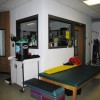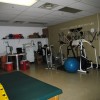Refrigerated display equipment is used to enhance product presentation and keep food at safe temperatures. 'Medium temperature merchandisers' is another term used for refrigerated display cases. They can typically be found in supermarkets, convenience stores, delis, bakeries and sushi bars. Refrigerated display cases can be either service, which involves an attendant handling the product, or self-service, where the customer handles the product. Generally, they can be classified as three types of cases: grab-n-go, reach-ins and countertop units. Grab-n-go units are self-service and are commonly found in supermarkets and convenience stores. They can be used for various products, such as produce, drinks, sandwiches, dairy, and others. Grab-n-go cases are open cases that can be wall units or island type cases. Reach-in cases typically have glass doors, and can also be found in supermarkets and convenience stores. They are used for products that require a steady temperature such as milk, eggs and other dairy products. Countertop units are used mainly for sushi and similar applications.

